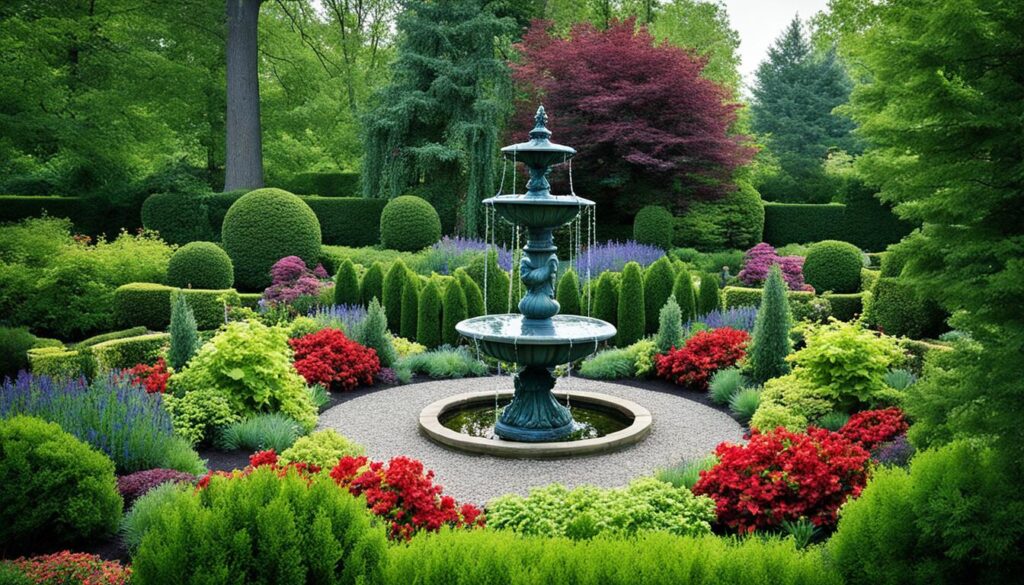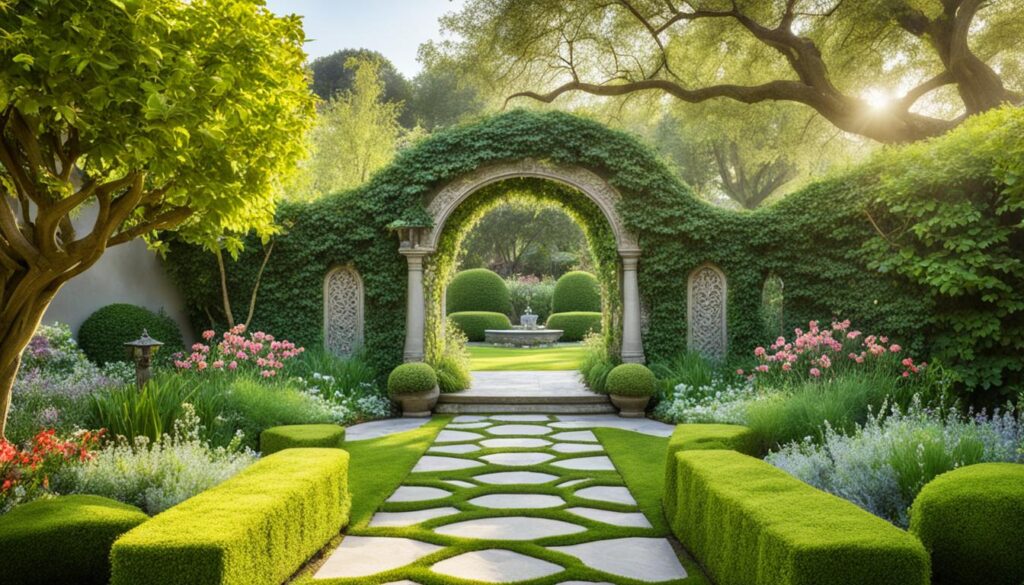Do you want to turn your garden into a stunning mix of nature and architecture? Imagine a scene where plants are kings, yet the sharp lines of structures add to its beauty. Here, we’ll show you how to add architecture to make your garden a gorgeous outdoor space.
The writer, once an architect, now loves gardening. They look at the garden as a city, with plants as its buildings. Inspired by the Forbidden City, their garden has straight lines so you can see from one end to the other.
To keep the garden beautiful all year, they use sharp edges, stone walls, evergreens, and a unique serpentine hedge. Hidden entrances guide you from one space to the next. Adding steps, walls, and gates brings character and charm to your garden, as advised by experts.
Wouldn’t it be amazing to make your garden a perfect mix of nature and architecture? How can you add structures to make it a beautiful outdoor space? Read on to learn these great ideas and how to use them in your own garden.
IN THIS ARTICLE
ToggleUnderstanding the Role of Architecture in Gardens
In garden design, architects and gardeners work together but often differently. They each have their own goals. The author talks about a struggle within themselves. One side loves garden order, the other side wants a wild, natural space. The author knows a neat garden often reflects a male’s influence. But they fight to keep their garden a beautiful, free oasis.
Imagine a garden is like a city. The plants are like its buildings. They fit together to form a bigger picture. This way of thinking shows how important it is to mix architecture with nature. It helps create a garden that not only looks good but feels right. By combining manmade and natural parts, the author tries to design stunning gardens.
The Duality of Architect and Gardener
The author struggles to blend two different garden design styles. They personify these as ‘Architectural Designer Me’ and ‘Plant Collector Me’. One side wants everything neat, while the other loves wild growth. Finding a middle ground is challenging. It needs deep knowledge in both garden and architectural designs.
Creating a Harmonious Balance
The goal is to make a garden where architecture doesn’t overpower nature. The author wants plants to be the focal point. By managing the tension between orderly design and natural growth, the author aims to make inviting spaces. These spaces should feel like home to plants but also look structured and beautiful.
Designing with Axial Arrangements
The author is inspired by the stunning architecture of the Forbidden City in Beijing. They often visit the city. The way the Forbidden City mixes big and small parts, and huge spaces with little ones, has greatly affected the author’s work in axial garden design and formal garden layouts.
The Influence of the Forbidden City
The author uses axial layouts in their garden design. It brings a sense of order and movement. But, it’s not overpowering, like in some famous French gardens. The axes in the garden link important parts together, like plants and buildings, making it feel smooth and natural.
Subtle Linear Relationships
Creating a garden inspired by the Forbidden City means looking at lines differently. Here, plants soften straight paths, mixing natural beauty with the rigid design. This approach achieves a unique balance. It lets the architecture and the greenery work together without one dominating the other.

Establishing a Strong Structural Framework
The garden structural framework is key in making outdoor areas look great all year long. It relies on clear boundaries and over 200 feet of neat squared-off stone walls. These features bring an organized feel and lead the eye smoothly around the garden.
The Importance of Sharp Edges and Clean Lines
The garden also uses various woody plants to define spaces, like yew and beech. There’s a detailed tapestry hedge that looks like a serpent, made of different evergreen shrubs, and a boulder wall with a boxwood hedge on top. Such precise garden elements ensure a strong year-round garden structure that looks good in every season.
Utilizing Hedges and Walls for Definition
The second source stresses adding structures like walls and steps to create garden definition. These elements help organize the area, drawing attention to special spots. By using hedges and walls for garden definition, you create a beautiful, flowing space where man-made and natural features harmonize.
Incorporating Focal Points and garden structures
To make a garden stand out, use focal points and architectural elements. These will catch the eye and spark imagination. Evergreen plants and sculptural shapes are key. They create a strong backbone for your garden all year.
The Role of Evergreens and Sculptural Plants
The first source’s writer cut back on flowers in an English border. They focused more on evergreens. This choice made the beds look good all year. It also cut down on upkeep. With examples like a long tapestry hedge and a boxwood hedge on a wall, the garden stays strong even in winter.
Creating Year-Round Interest
Using evergreens wisely is important. Placing topiary and other sculptural plants can grab attention and beautify the garden. The second source shows how these shapes draw the eye and add a formal touch. Even in a natural-looking garden, they bring elegance. The third source agrees, saying combining evergreens and sculptural plants keeps the garden looking good year-round.

Defining Spaces with Gateways
When you design a garden, think about how to use gateways wisely. They help separate and connect different parts of your garden. Subtle garden gateways can be as simple as two trimmed shrubs or as complex as arbors and pergolas. They show a passage from one area to another without making it all feel cut off, as some traditional garden rooms can do.
Transitioning Between Garden Areas
Transitional gateways guide people into your garden world, showing them where to go next. They use architectural features to lead the way smoothly while defining separate garden zones clearly. These structures make your garden special, offering surprises and excitement as people walk through your beautifully designed outdoor space.
Architectural Gateways and Arbors
Looking to make a grander garden? Think about including architectural garden structures like formal gateways and graceful arbors. These elements add elegance and guide the view, making your garden feel enclosed in parts while highlighting its beauty. No matter the size, such gateways and structures improve your garden’s flow and beauty.

Achieving Balance Through Pruning
Getting your garden pruning just right is key. It keeps your garden beautiful and balanced. The balance of scale and proportion is vital, as a famous author explains. Pruning keeps this balance spot on.
The secret is to prune consistently, not just in one season. By always adjusting plant sizes and shapes, everything looks just as it should. This maintains a perfect balance in your green space.
In a full, mature garden, pruning beats back overgrowth. It stops the place from turning into a wild «jungle.» This intense care keeps the garden looking like a work of art, not a mess.
| Pruning Technique | Benefit |
|---|---|
| Selective, year-round pruning | Maintains desired scale and proportion in mature, densely planted gardens |
| Altering proportions of individual elements | Ensures the relationship between garden structures, plants, and other features remains in harmony |
| Constant vigilance and «always be pruning» mindset | Prevents the garden from becoming an unmanageable «jungle» and preserves its architectural integrity |
Lighting and Enhancing Architectural Elements
Strategic garden lighting is key for highlighting your garden’s best features. It makes unique structures shine at night. This is especially true for outdoor dining areas, creating a special atmospheric environment.
Illuminating Key Features
Let’s look at how lighting enhances garden architecture. For instance, olive trees stand out with the right lights. These trees are not just trees; they add to the garden’s form. Big planters help too, giving a strong, structural feel thanks to garden lighting.
Atmospheric Dining Areas
Lighting does more than show off architectural details. It can also make outdoor dining areas feel cozy. Take the example of using lights to show off statues. This adds a neat focal point and makes dining more special.
Incorporating Unique garden structures
Creating unique garden structures can make your outdoor spaces stand out. It could be a stylish shed or a fun treehouse. These touches add a lot of character to your garden.
Sheds as Architectural Statements
«Pimping your shed» is an interesting idea from the second source. It turns a plain shed into a design piece. Add windows, doors, and bright paint to make a simple shed catch everyone’s eye. These unique sheds can be stunning additions to your garden.
Building Treehouses as Focal Points
Consider a treehouse if you have the room and funds, says the third source. They can look like cozy forest cabins or adventurous jungle hideaways. Either way, a treehouse adds a unique focal point that appeals to guests. It’s a special way to bring charm to your outdoor spaces.
Maintaining Scale and Proportion
As someone who once designed buildings, now you know how vital scale and proportion are in an outdoor space. These ideas are tough for most gardeners to grasp. Yet, when designing a garden, getting the right scale and proportion is key. It leads to a landscape that feels whole and beautiful.
You manage this balance well by always pruning carefully. You keep at it year-round to make sure everything fits together just right. With each trim, your garden’s balance is kept, stopping it from becoming a wild mess that hides your designs.
Your commitment to keeping the right scale and proportion shows your deep love for garden design. You see the beauty in how both man-made and natural aspects blend. This perfect mix, achieved through careful pruning, makes your garden a stunning unity of architecture and nature.



